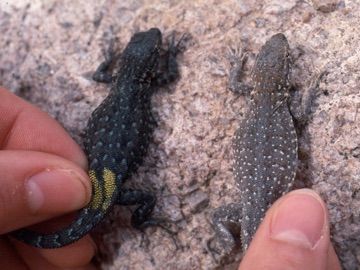Populations of side-blotched lizards at the Pisgah Lava Flow in southern California have diverged from populations just off the lava flow. Populations on the Pisgah Lava Flow have two mating strategies and dark dorsal coloration (the above lizard on the left), whereas populations off the lava have three strategies and lighter coloration (the lizard on the right). I conducted genetic crosses to test whether populations on and off the lava flow showed evidence of reproductive isolation. These tests revealed that females from the dimorphic lava population had reduced fitness when crossed to males from a neighboring trimorphic off-lava population. This experiment also showed that orange male morphs had lower fitness when mated between populations. The reductions in fertility likely arise from cryptic female choice and/or sperm-egg incompatibilities because between-population crosses had greater numbers of unfertilized eggs. This study was the first to demonstrate that populations differing in numbers of morphs can exhibit reproductive isolation, which was an important step in determining how polymorphism might contribute to the formation of new species.
Publications
Corl, A., L.T. Lancaster, and B. Sinervo. 2012. Rapid formation of reproductive isolation between two populations of Side-Blotched lizards, Uta stansburiana. Copeia 4: 593-602. [link]


